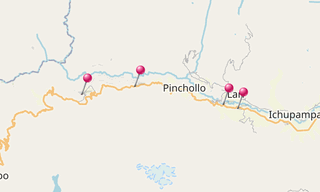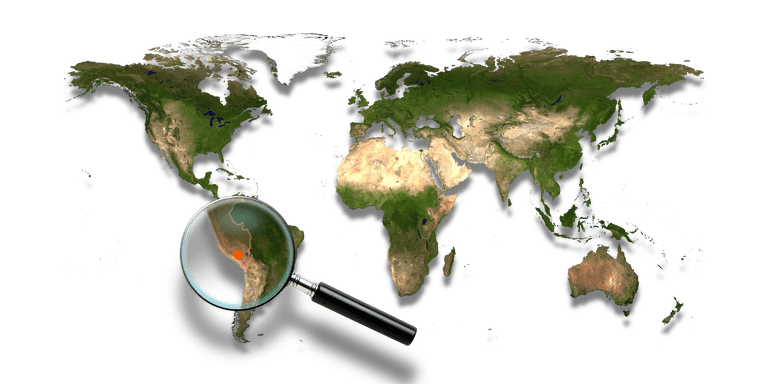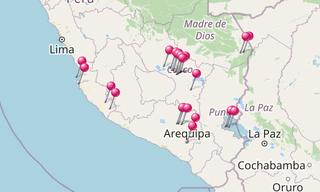The Colca Canyon is a canyon of the Colca River in southern Peru located about 160 km north-west of Arequipa. With up to 3,270 m, it is one of the deepest canyons in the world. The colourful valley is the home of the Andean Condor (Vultur gryphus). The name Colca refers to small holes in the cliffs used in Inca and pre-Inca times as tombs and to store potatoes and crops. The Inca probably arrived in the Colca Valley around 1320 AD, and established their dominion through marriage, rather than through warfare. Chivay, Maca, Cabanaconde: A series of small villages is spread along the valley.
Cruz del Condor
Cruz del Condor is a pass where condors soar gracefully on the rising thermals occurring as the air warms; the canyon floor is 1,200 m below the rim of the canyon.
Cabanaconde
Cabanaconde is 40 km west of Chivay in the southwest of the Caylloma province at 3,287 m above sea level. The first settlers before Inca were the Cabanas, and their legends indicate that they came from the snow-capped Hualca Hualca. The name of Cabana comes from the Quechua word “Qhawana”. In July the Fiesta de la Virgen del Carmen is celebrated in Cabanaconde.
Maca
Maca is located 18 km west of Chivay on the left bank of the Colca River at an altitude of 3,262 m above sea level. The name comes from Maca an herbaceous plant from the Andes. In addition to its dietary use, it is argued that its roots have properties that increase fertility. The Catholic parish church of Santa Ana de Maca was destroyed by the earthquake in 1991 and restored until 2006.

-Andean-Condor.hero.landscape.jpg)

.jpg?w=256)
-Andean-Condor.jpg?w=256)
.jpg?w=256)
-Fiesta-de-la-Virgen-del-Carmen.jpg?w=256)
-Andean-Condor.jpg?w=256)
-Iglesia-de-Santa-Ana-de-Maca.jpg?w=256)
.jpg?w=256)
-Iglesia-de-Santa-Ana-de-Maca.jpg?w=256)
.jpg?w=256)
.jpg?w=256)
-Iglesia-de-Santa-Ana-de-Maca.jpg?w=256)
-Andean-Condor.jpg?w=256)
.jpg?w=256)
.jpg?w=256)
-Andean-Condor.jpg?w=256)
.jpg?w=256)
-Iglesia-de-Santa-Ana-de-Maca.jpg?w=256)
-Fiesta-de-la-Virgen-del-Carmen.jpg?w=256)
.jpg?w=256)
-Andean-Condor.jpg?w=256)
-Fiesta-de-la-Virgen-del-Carmen.jpg?w=256)
-Fiesta-de-la-Virgen-del-Carmen.jpg?w=256)
-Andean-Condor.jpg?w=256)
.jpg?w=256)
.jpg?w=256)
.jpg?w=256)
-Fiesta-de-la-Virgen-del-Carmen.jpg?w=256)
.jpg?w=256)
-Iglesia-de-Santa-Ana-de-Maca.jpg?w=256)
.jpg?w=256)
-Fiesta-de-la-Virgen-del-Carmen.jpg?w=256)
.jpg?w=256)
-Fiesta-de-la-Virgen-del-Carmen.jpg?w=256)
.jpg?w=256)
.jpg?w=256)
-Andean-Condor.jpg?w=256)
.jpg?w=256)
.jpg?w=256)
.jpg?w=256)
.jpg?w=256)
-Fiesta-de-la-Virgen-del-Carmen.jpg?w=256)
-Fiesta-de-la-Virgen-del-Carmen.jpg?w=256)
.jpg?w=256)
.jpg?w=256)
-Fiesta-de-la-Virgen-del-Carmen.jpg?w=256)
-Fiesta-de-la-Virgen-del-Carmen.jpg?w=256)
-Iglesia-de-Santa-Ana-de-Maca.jpg?w=256)
.jpg?w=256)
.hero.jpg?w=320)

.hero.jpg?w=320)

.jpg?w=256)
-Andean-Condor.jpg?w=256)
.jpg?w=256)
-Iglesia-de-Santa-Ana-de-Maca.jpg?w=256)
.jpg?w=256)
.jpg?w=256)
-Fiesta-de-la-Virgen-del-Carmen.jpg?w=256)
-Fiesta-de-la-Virgen-del-Carmen.jpg?w=256)
.jpg?w=256)
-Andean-Condor.jpg?w=256)
-Andean-Condor.jpg?w=256)
-Fiesta-de-la-Virgen-del-Carmen.jpg?w=256)
-Fiesta-de-la-Virgen-del-Carmen.jpg?w=256)
.jpg?w=256)
-Andean-Condor.jpg?w=256)
.jpg?w=256)
-Fiesta-de-la-Virgen-del-Carmen.jpg?w=256)
.jpg?w=256)
-Iglesia-de-Santa-Ana-de-Maca.jpg?w=256)
-Andean-Condor.jpg?w=256)
-Fiesta-de-la-Virgen-del-Carmen.jpg?w=256)
-Andean-Condor.jpg?w=256)
-Fiesta-de-la-Virgen-del-Carmen.jpg?w=256)
.jpg?w=256)
-Iglesia-de-Santa-Ana-de-Maca.jpg?w=256)
-Andean-Condor.jpg?w=256)
-Fiesta-de-la-Virgen-del-Carmen.jpg?w=256)
.jpg?w=256)
.jpg?w=256)
-Andean-Condor.jpg?w=256)
-Fiesta-de-la-Virgen-del-Carmen.jpg?w=256)
.jpg?w=256)
.jpg?w=256)
-Andean-Condor.jpg?w=256)
-Fiesta-de-la-Virgen-del-Carmen.jpg?w=256)
.jpg?w=256)
-Andean-Condor.jpg?w=256)
-Andean-Condor.jpg?w=256)
-Andean-Condor.jpg?w=256)
.jpg?w=256)
.jpg?w=256)
.jpg?w=256)
-Fiesta-de-la-Virgen-del-Carmen.jpg?w=256)
.jpg?w=256)
.jpg?w=256)
-Fiesta-de-la-Virgen-del-Carmen.jpg?w=256)
-Fiesta-de-la-Virgen-del-Carmen.jpg?w=256)
.jpg?w=256)
-Fiesta-de-la-Virgen-del-Carmen.jpg?w=256)
-Iglesia-de-Santa-Ana-de-Maca.jpg?w=256)
-Andean-Condor.jpg?w=256)
-Fiesta-de-la-Virgen-del-Carmen.jpg?w=256)
-Fiesta-de-la-Virgen-del-Carmen.jpg?w=256)
-Andean-Condor.jpg?w=256)
-Andean-Condor.jpg?w=256)
-Andean-Condor.jpg?w=256)
-Iglesia-de-Santa-Ana-de-Maca.jpg?w=256)
.jpg?w=256)
-Iglesia-de-Santa-Ana-de-Maca.jpg?w=256)
-Fiesta-de-la-Virgen-del-Carmen.jpg?w=256)
-Fiesta-de-la-Virgen-del-Carmen.jpg?w=256)
-Fiesta-de-la-Virgen-del-Carmen.jpg?w=256)
.jpg?w=256)
.jpg?w=256)
-Fiesta-de-la-Virgen-del-Carmen.jpg?w=256)
.jpg?w=256)
-Andean-Condor.jpg?w=256)
.jpg?w=256)
-Andean-Condor.jpg?w=256)
-Andean-Condor.jpg?w=256)
-Fiesta-de-la-Virgen-del-Carmen.jpg?w=256)
-Iglesia-de-Santa-Ana-de-Maca.jpg?w=256)